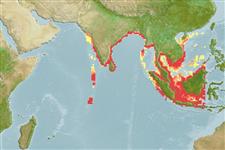Environment: milieu / climate zone / depth range / distribution range
Ökologie
seewasser; süßwasser; brackwasser; anadrom (Ref. 51243); tiefenbereich 0 - 50 m (Ref. 188). Tropical; 24°N - 10°S, 70°E - 118°E (Ref. 188)
Indo-Pacific: Indian Ocean (Bombay to Bay of Bengal and Andaman coast of Thailand), Java Sea (off Java, Singapore). Sarawak, `Cochinchina' and Macao specimens (Ref. 6393) should be rechecked.
Size / Gewicht / Alter
Maturity: Lm ? range ? - ? cm
Max length : 36.5 cm SL Männchen/unbestimmt; (Ref. 108866)
Rückenflossenstacheln (insgesamt) : 0; Afterflossenstacheln: 0; Afterflossenweichstrahlen: 38 - 53. Body rather deep, belly with 19 to 23 + 8 to 12, total 28 to 35 (usually 30 to 34) scutes. Eye large, lower jaw strongly projecting. Dorsal fin origin near midpoint of body; anal fin origin below hind part of dorsal fin base. Swim bladder with a single long tube passing back down right side of body above anal fin base. No toothed hypo-maxilla.
An inshore species, but apparently occurs also in rivers (Ganges at Allahabad and rivers of eastern Uttar Pradesh, but not in Velar estuary). Ascends into the upper end of the tidal zone (Ref. 12693). Feeds on fishes, crustaceans, amphipods, occasionally polychaetes, tunicates and small amounts of algae and diatoms.
Life cycle and mating behavior
Geschlechtsreife | Fortpflanzung | Ablaichen | Eier | Fecundity | Larven
Whitehead, P.J.P., 1985. FAO Species Catalogue. Vol. 7. Clupeoid fishes of the world (suborder Clupeoidei). An annotated and illustrated catalogue of the herrings, sardines, pilchards, sprats, shads, anchovies and wolf-herrings. FAO Fish. Synop. 125(7/1):1-303. Rome: FAO. (Ref. 188)
IUCN Rote Liste Status (Ref. 130435: Version 2024-2)
Bedrohung für Menschen
Harmless
Nutzung durch Menschen
Fischereien: kommerziell
Tools
Zusatzinformationen
Download XML
Internet Quellen
Estimates based on models
Preferred temperature (Ref.
123201): 27.7 - 29.3, mean 28.8 °C (based on 614 cells).
Phylogenetic diversity index (Ref.
82804): PD
50 = 0.5000 [Uniqueness, from 0.5 = low to 2.0 = high].
Bayesian length-weight: a=0.00832 (0.00555 - 0.01247), b=2.96 (2.84 - 3.08), in cm total length, based on LWR estimates for this species & Genus-body shape (Ref.
93245).
Trophic level (Ref.
69278): 3.0 ±0.37 se; based on food items.
Widerstandsfähigkeit (Ref.
120179): mittel, Verdopplung der Population dauert 1,4 - 4,4 Jahre. (Preliminary K or Fecundity.).
Fishing Vulnerability (Ref.
59153): Low to moderate vulnerability (35 of 100).
Nutrients (Ref.
124155): Calcium = 132 [81, 261] mg/100g; Iron = 1.39 [0.82, 2.19] mg/100g; Protein = 19.2 [17.8, 20.6] %; Omega3 = 0.362 [0.193, 0.677] g/100g; Selenium = 41.4 [22.1, 83.1] μg/100g; VitaminA = 17.9 [7.0, 42.7] μg/100g; Zinc = 1.68 [1.23, 2.33] mg/100g (wet weight);
